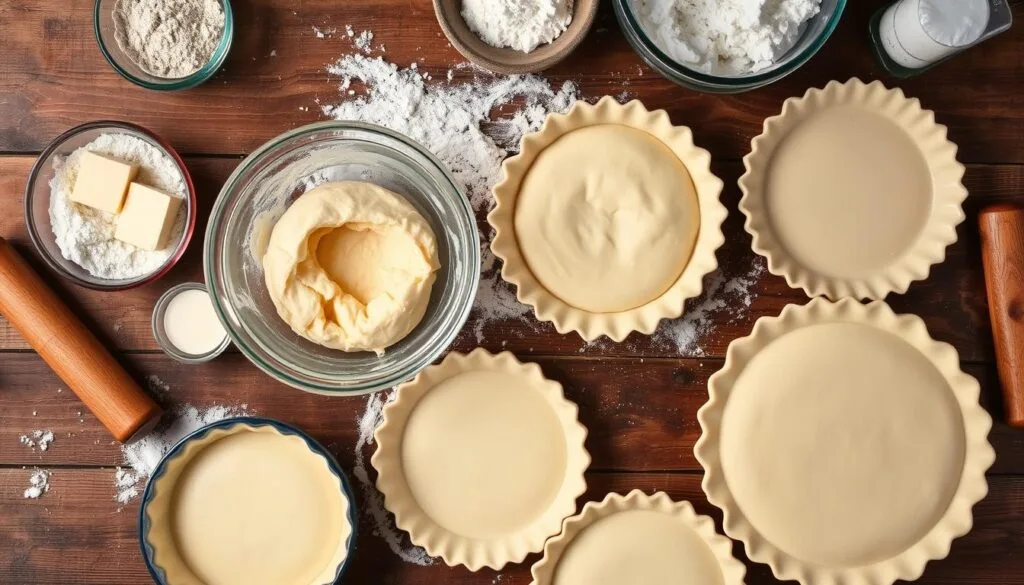Best Pie Crust for Pot Pie: Homemade and Store-Bought Options
Every home cook knows the magic of a perfect pot pie starts with its crust. That first crisp, flaky bite can turn an ordinary meal into a memorable one. Whether you’re a busy parent or a passionate home baker, choosing the right pie crust is key.
Store-bought pie crusts have improved a lot. Brands like Trader Joe’s offer refrigerated options for under $3. Popular crusts cost around $5.50 for two. These options save time without losing much flavor. Blind taste tests show some store-bought crusts can match homemade ones in taste and texture.
The homemade pie crust is still the top choice for those willing to put in the effort. With simple ingredients like flour, cold butter, and ice water, you can make a crust that shows your cooking passion. The trick is knowing the details of making a crust and picking the right method for your pot pie.
Your pot pie deserves a crust that’s more than just a container. It should be a highlight of the dish. This guide will look at both homemade and store-bought options. It will help you choose with confidence and culinary skill.
Table of Contents
Understanding the Essentials of Pie Crust for Pot Pie
Making the perfect pot pie crust is all about knowing your ingredients and techniques. Whether you’re cooking at home or dreaming of baking, learning pie crust can change your cooking game.
Key Ingredients for Perfect Pot Pie Crust
Choosing the right ingredients is key for a tasty pot pie crust. You’ll need:
- Unbleached all-purpose flour (2 ½ cups)
- Cold unsalted butter (1 cup or 2 sticks)
- Ice water (8 tablespoons)
- Salt (1 teaspoon)
- Optional: 1 teaspoon granulated sugar
Butter vs. Shortening in Crust Making
The choice between butter and shortening is a big one in pie crust making. Butter gives a richer flavor and a golden crust. Shortening, on the other hand, melts less and is easier to work with.
The Role of Temperature in Crust Success
Cold ingredients are the key to a flaky pie crust. Keeping butter and water cold stops the fat from melting too soon. Try to keep your ingredients cold until you mix them.
“You do not want to over stir this too much, it will change the texture. Combine it all within a bowl with a pastry cutter ideally.”
Pro tip: Chill your dough for at least 1 hour before rolling. This lets the gluten relax, making your crust tender and flaky.
Top Store-Bought Pie Crust Brands for Pot Pies
Finding the right premade pie crust can make your cooking better. Not all store-bought crusts are the same. You need to pick carefully.
Several brands are known for their quality and taste:
- Pillsbury Refrigerated Rolled Pie Crusts (9.5/10 rating)
- Marie Callender’s Deep Dish Pastry Pie Shells (9.5/10 rating for savory pies)
- Wholly Wholesome Gluten Free Pie Crust (7.5/10 rating)
Pillsbury is the top choice for pot pie crust. They have a rating of 9.5/10. Their crusts are:
- Flaky and consistent
- Easy to prepare
- Strong and reliable
“If you want a crust that tastes homemade, this is the one.” – Baking Expert
Price is important when picking a pie crust. Here’s a quick look:
| Brand | Price | Rating |
|---|---|---|
| Pillsbury | $3.50 | 9.5/10 |
| Giant Eagle | $2.49 | 7/10 |
| Marie Callender’s | $5.69 | 9.5/10 |
For those who need gluten-free, Wholly Wholesome offers a gluten-free option. Think about your needs, budget, and what you want when picking a pie crust.
Making the Perfect Homemade Pie Crust for Pot Pie
Making a homemade pot pie crust is all about precision and care. The right techniques can turn your pie into something truly special. You’ll get a flaky crust that will wow anyone.
Essential Ingredients for Success
To make the ultimate homemade pot pie crust, you’ll need these key ingredients:
- 2 ½ cups all-purpose flour
- 1 cup very cold unsalted butter, cubed
- 6-8 tablespoons ice water
- 1 teaspoon kosher salt
- Optional: 1 tablespoon sugar
Step-by-Step Mixing Technique
Mastering flaky pie crust techniques starts with mixing. Use a pastry blender or two butter knives to get a crumbly texture. Aim for pea-sized butter pieces for those flaky layers.
“Cold ingredients are the secret to a perfect pie crust” – Baking Experts
Rolling and Shaping Perfection
Roll out your dough to a ¼-inch thickness. Work fast to keep the butter cold. This helps keep your crust flaky.
Pro Tips for a Flaky Texture
- Chill your ingredients and tools before starting
- Handle the dough minimally to prevent gluten development
- Rest the dough for at least 4 hours before using
- Consider an egg wash for beautiful golden browning
Remember, practice makes perfect with homemade pot pie crust. Follow these tips to create a crust that’s both delicious and impressive.
Pillsbury Refrigerated Pie Crusts: The Market Leader
Pillsbury refrigerated pie crust is a top choice for making pot pies at home. It holds a 50% market share in the pie crust segment. This makes it a leader in the market.
- Quick and easy preparation
- Consistent golden color when baked
- Thin and crisp texture
- Versatile for multiple filling types
Many consumers love Pillsbury pie crust. About 65% of people prefer pre-made pie crusts, with Pillsbury being the favorite. The 25-44 age group makes up 40% of buyers, showing its appeal to younger adults.
“A great golden color and sturdy enough to stand up to various fillings” – Culinary Tester
| Market Metric | Pillsbury Performance |
|---|---|
| Market Share | 50% |
| Annual Growth Rate | 6% |
| Consumer Preference | 65% |
When picking a Pillsbury pie crust for your pot pie, look for a mix of convenience and taste. Some taste tests rank it low, but many cooks value its ease and reliability.
Choosing Pillsbury pie crust can make making pot pies easier. It lets you focus on making tasty fillings and enjoying a quick, satisfying meal.
Deep Dish Options for Heartier Pot Pies
Craving a more filling pot pie? Deep dish options are the answer. These sturdy crusts hold more filling, making your meal more fulfilling.
Marie Callender’s Deep Dish Advantages
Marie Callender’s pie crust is a favorite for many. It’s known for its convenience and quality. Here’s why it’s a top pick:
- Buttery flavor that enhances overall taste
- Multiple flaky layers for perfect texture
- Generous depth for substantial fillings
- Pre-shaped for easy preparation
Comparing Deep Dish Alternatives
Not all deep dish pot pie crusts are the same. Here’s a comparison:
| Brand | Depth | Flavor Profile | Ease of Use |
|---|---|---|---|
| Marie Callender’s | Extra Deep | Rich Buttery | Excellent |
| Pillsbury | Standard | Mild Butter | Good |
| Homemade | Customizable | Fresh Ingredients | Variable |
Choosing the right deep dish pot pie crust can make your cooking stand out. Whether you go for Marie Callender’s or make your own, pick one that matches your recipe.
“A great pot pie begins with an exceptional crust” – Culinary Experts
Budget-Friendly Pie Crust Options

Making a tasty pot pie doesn’t have to cost a lot. Clever cooks find ways to make an affordable pie crust without losing flavor. You can choose from many cheap pie crust options or find budget-friendly alternatives.
Looking for an affordable pie crust? Here are some smart tips:
- Homemade crusts can cost between $1.50 to $3.00 to make
- Store-bought crusts range from $2.00 to $5.00 per package
- Bulk preparation can significantly reduce overall costs
Homemade crusts are a big money-saver. About 15% of home cooks use cheaper flours to save money. With ingredients like all-purpose flour, butter, and salt, you can make a tasty crust for less than store-bought ones.
“At less than $3 for two crusts, this option is hard to beat!” – Home Cooking Expert
Interesting facts come from consumer data. 70% of people like store-bought crusts for ease, while 60% prefer homemade for better taste. Making a homemade crust takes only 15-20 minutes, saving time and money.
Pro tip: Use leftovers and freeze extra dough to avoid waste. Homemade crusts can cut down on waste by about 30% compared to pre-made ones.
Storage and Preparation Tips for Pie Crusts
Learning how to store and prepare pie crusts can make your pot pies amazing. Whether you make your own or buy them, knowing the right steps is key. This way, you’ll get a flaky and delicious pie crust every time.
Optimal Pie Crust Storage Methods
Storing pie crusts right is important for keeping them fresh and flaky. Here are some tips to help you:
- Refrigerate prepared pie dough for up to 3 days
- Freeze pie dough for extended storage up to 3 months
- Wrap dough tightly in plastic wrap to prevent moisture loss
- Store baked pie crusts in an airtight container
Preparing Frozen Pie Crust Like a Pro
Here’s how to prepare frozen pie crust like a pro:
- Thaw frozen pie crust overnight in the refrigerator
- Remove from refrigerator 15-20 minutes before rolling
- Roll out dough on a lightly floured surface
- Aim for a consistent ⅜-inch thickness
“The secret to a perfect pie crust is patience and temperature control.”
Handling Tips for Best Results
Here are some tips to keep your pie crust in great shape:
- Always handle dough gently to maintain flakiness
- Avoid overworking the dough to prevent toughness
- Use cold ingredients for the most tender crust
- Consider pre-rolling dough before refrigeration
By following these tips, you’ll make pot pies that look and taste like they were made by a pro. Remember, the more you practice, the better you’ll get!
Common Mistakes to Avoid When Working with Pot Pie Crusts
Making the perfect pot pie crust can be tricky. Knowing common mistakes helps you get it right. Start by understanding what can go wrong.

Here are the most critical errors to watch out for when making your pot pie crust:
- Overworking the Dough: Too much mixing makes the crust tough and chewy, not light and flaky.
- Using Warm Ingredients: Keep butter and other ingredients cold to keep the crust delicate.
- Incorrect Flour Measurement: Use a digital scale for accurate flour weighing.
- Improper Mixing Techniques: Hand mixing can overwork, while a food processor keeps the right consistency.
“You do not want to over stir this too much, it will change the texture.” – Professional Chef
Temperature is key for pie crust success. Warm butter can ruin the flaky layers. Bakers say to use cold, cubed butter and handle it little to keep the texture right.
| Mistake | Consequence | Solution |
|---|---|---|
| Warm Butter | Greasy, tough crust | Use cold, cubed butter |
| Overmixing | Develops excess gluten | Mix minimally, use food processor |
| Improper Measuring | Inconsistent texture | Use digital scale for accuracy |
Pro tips say pre-bake the bottom crust to about 75% to avoid a soggy bottom. A glass pie plate helps with better browning and even cooking.
Remember, practice makes perfect. Don’t get discouraged if your first few attempts aren’t flawless. Each pie crust is a chance to get better and make a delicious, flaky pot pie.
Advanced Techniques for Professional-Looking Pot Pie Crusts
Creating stunning decorative pie crust designs can turn a simple pot pie into a masterpiece. Your pot pie crust is more than a cover. It’s a canvas for creativity that makes the dining experience better.
Professional bakers use several techniques to make pot pie crusts look amazing:
- Lattice Crust: Weave strips of dough for an intricate top layer
- Braided Edge: Create a beautiful border around the pie’s rim
- Cut-Out Shapes: Add decorative elements like leaves or geometric patterns
- Crimped Edges: Use your fingers to create elegant, scalloped borders
To get a professional-looking pot pie crust, try these advanced techniques:
- Chill your dough before rolling to maintain sharp edges
- Use sharp kitchen scissors for precise cut-out designs
- Brush with egg wash for a golden, glossy finish
- Practice consistent thickness when rolling out crust
“A beautifully designed pot pie crust turns a simple meal into a work of art.” – Culinary Expert
| Technique | Difficulty Level | Visual Impact |
|---|---|---|
| Lattice Crust | Intermediate | High |
| Braided Edge | Advanced | Very High |
| Cut-Out Designs | Beginner | Medium |
Remember, practice makes perfect when creating decorative pot pie crust designs. Each attempt will improve your skills and confidence. You’ll be able to make pot pies that are as beautiful as they are delicious.
Conclusion
Choosing the right pie crust for pot pie is an art. It’s about finding a balance between ease and creativity. Whether you make it yourself or buy it, it’s all about your cooking style and how much time you have.
Looking into homemade and store-bought options can open up new possibilities. Brands like Pillsbury offer quick solutions, while making your own crust can be rewarding. The choice depends on your skill, time, and how adventurous you are in the kitchen.
Don’t worry if it takes a few tries to get it right. Every pot pie you make is a chance to get better, whether you’re making the crust from scratch or using a pre-made one. The flaky, golden crust you get is proof of your creativity, turning simple ingredients into a cozy meal.
Your pot pie adventure is just starting. Keep trying new things, making new recipes, and most importantly, have fun. The perfect pot pie is out there, waiting for you to find it.







